Analyzing Oporto's Advert and Marketing Strategies
VerifiedAdded on 2023/06/07
|9
|1634
|351
AI Summary
This article analyzes Oporto's advert and marketing strategies using Maslow's hierarchy of needs, Bernbach ROI Framework, and Vaughn FCB involvement matrix. It also provides recommendations for designing successful print ads.
Contribute Materials
Your contribution can guide someone’s learning journey. Share your
documents today.
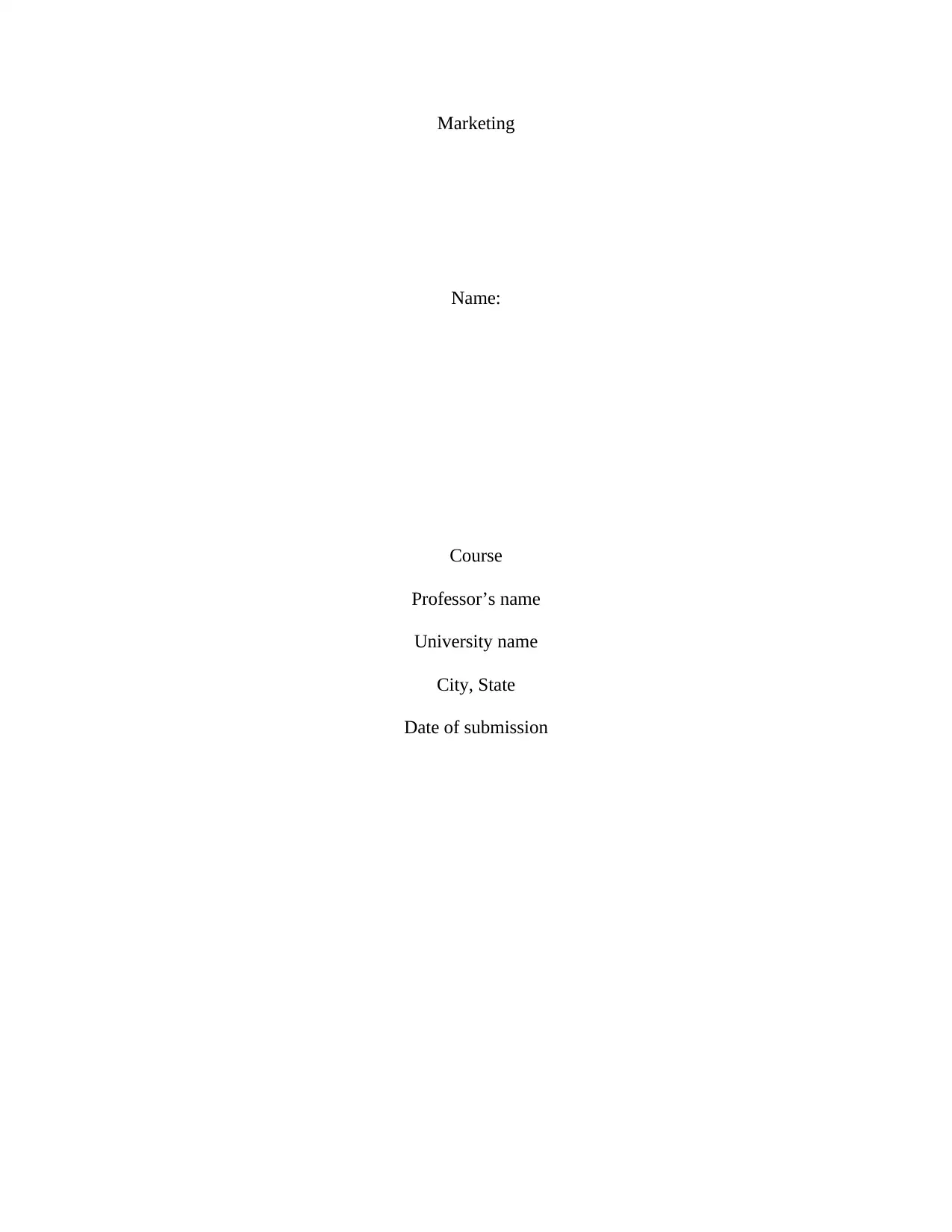
Marketing
Name:
Course
Professor’s name
University name
City, State
Date of submission
Name:
Course
Professor’s name
University name
City, State
Date of submission
Secure Best Marks with AI Grader
Need help grading? Try our AI Grader for instant feedback on your assignments.
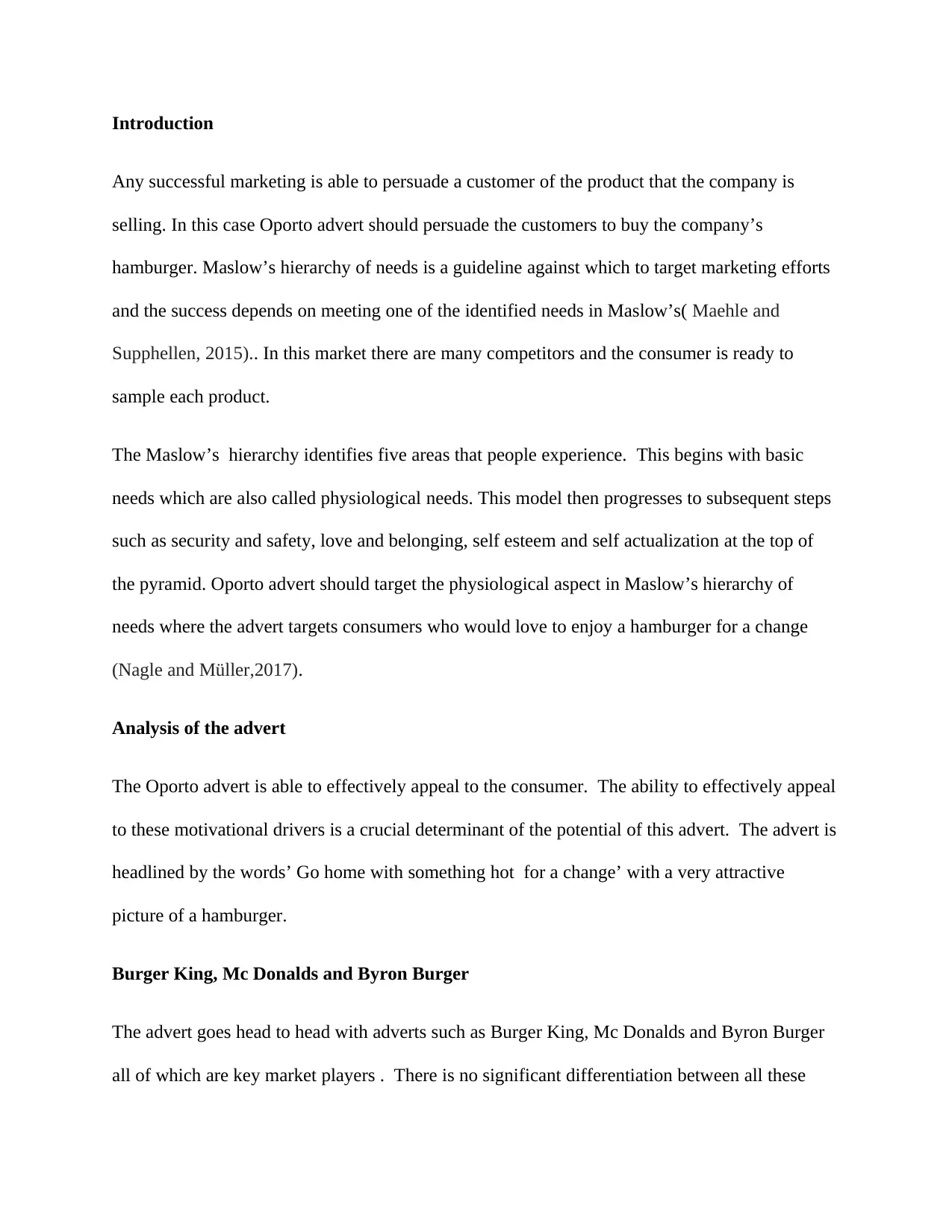
Introduction
Any successful marketing is able to persuade a customer of the product that the company is
selling. In this case Oporto advert should persuade the customers to buy the company’s
hamburger. Maslow’s hierarchy of needs is a guideline against which to target marketing efforts
and the success depends on meeting one of the identified needs in Maslow’s( Maehle and
Supphellen, 2015).. In this market there are many competitors and the consumer is ready to
sample each product.
The Maslow’s hierarchy identifies five areas that people experience. This begins with basic
needs which are also called physiological needs. This model then progresses to subsequent steps
such as security and safety, love and belonging, self esteem and self actualization at the top of
the pyramid. Oporto advert should target the physiological aspect in Maslow’s hierarchy of
needs where the advert targets consumers who would love to enjoy a hamburger for a change
(Nagle and Müller,2017).
Analysis of the advert
The Oporto advert is able to effectively appeal to the consumer. The ability to effectively appeal
to these motivational drivers is a crucial determinant of the potential of this advert. The advert is
headlined by the words’ Go home with something hot for a change’ with a very attractive
picture of a hamburger.
Burger King, Mc Donalds and Byron Burger
The advert goes head to head with adverts such as Burger King, Mc Donalds and Byron Burger
all of which are key market players . There is no significant differentiation between all these
Any successful marketing is able to persuade a customer of the product that the company is
selling. In this case Oporto advert should persuade the customers to buy the company’s
hamburger. Maslow’s hierarchy of needs is a guideline against which to target marketing efforts
and the success depends on meeting one of the identified needs in Maslow’s( Maehle and
Supphellen, 2015).. In this market there are many competitors and the consumer is ready to
sample each product.
The Maslow’s hierarchy identifies five areas that people experience. This begins with basic
needs which are also called physiological needs. This model then progresses to subsequent steps
such as security and safety, love and belonging, self esteem and self actualization at the top of
the pyramid. Oporto advert should target the physiological aspect in Maslow’s hierarchy of
needs where the advert targets consumers who would love to enjoy a hamburger for a change
(Nagle and Müller,2017).
Analysis of the advert
The Oporto advert is able to effectively appeal to the consumer. The ability to effectively appeal
to these motivational drivers is a crucial determinant of the potential of this advert. The advert is
headlined by the words’ Go home with something hot for a change’ with a very attractive
picture of a hamburger.
Burger King, Mc Donalds and Byron Burger
The advert goes head to head with adverts such as Burger King, Mc Donalds and Byron Burger
all of which are key market players . There is no significant differentiation between all these

burgers from the various companies, what is really different is the pricing and some have a
differentiating taste. This marketing is aimed at the down most segment of the hierarchy of needs
which physiological needs such as food.
differentiating taste. This marketing is aimed at the down most segment of the hierarchy of needs
which physiological needs such as food.
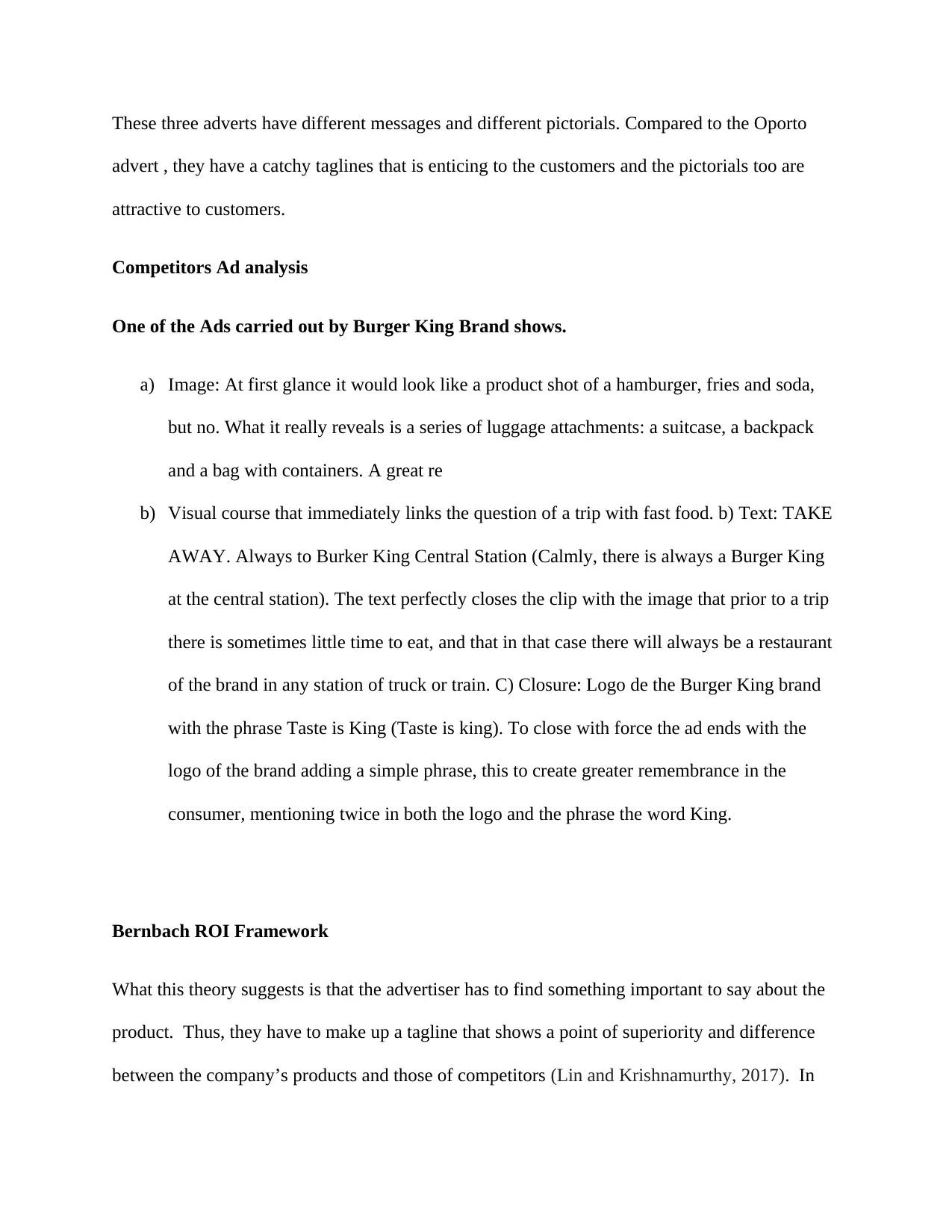
These three adverts have different messages and different pictorials. Compared to the Oporto
advert , they have a catchy taglines that is enticing to the customers and the pictorials too are
attractive to customers.
Competitors Ad analysis
One of the Ads carried out by Burger King Brand shows.
a) Image: At first glance it would look like a product shot of a hamburger, fries and soda,
but no. What it really reveals is a series of luggage attachments: a suitcase, a backpack
and a bag with containers. A great re
b) Visual course that immediately links the question of a trip with fast food. b) Text: TAKE
AWAY. Always to Burker King Central Station (Calmly, there is always a Burger King
at the central station). The text perfectly closes the clip with the image that prior to a trip
there is sometimes little time to eat, and that in that case there will always be a restaurant
of the brand in any station of truck or train. C) Closure: Logo de the Burger King brand
with the phrase Taste is King (Taste is king). To close with force the ad ends with the
logo of the brand adding a simple phrase, this to create greater remembrance in the
consumer, mentioning twice in both the logo and the phrase the word King.
Bernbach ROI Framework
What this theory suggests is that the advertiser has to find something important to say about the
product. Thus, they have to make up a tagline that shows a point of superiority and difference
between the company’s products and those of competitors (Lin and Krishnamurthy, 2017). In
advert , they have a catchy taglines that is enticing to the customers and the pictorials too are
attractive to customers.
Competitors Ad analysis
One of the Ads carried out by Burger King Brand shows.
a) Image: At first glance it would look like a product shot of a hamburger, fries and soda,
but no. What it really reveals is a series of luggage attachments: a suitcase, a backpack
and a bag with containers. A great re
b) Visual course that immediately links the question of a trip with fast food. b) Text: TAKE
AWAY. Always to Burker King Central Station (Calmly, there is always a Burger King
at the central station). The text perfectly closes the clip with the image that prior to a trip
there is sometimes little time to eat, and that in that case there will always be a restaurant
of the brand in any station of truck or train. C) Closure: Logo de the Burger King brand
with the phrase Taste is King (Taste is king). To close with force the ad ends with the
logo of the brand adding a simple phrase, this to create greater remembrance in the
consumer, mentioning twice in both the logo and the phrase the word King.
Bernbach ROI Framework
What this theory suggests is that the advertiser has to find something important to say about the
product. Thus, they have to make up a tagline that shows a point of superiority and difference
between the company’s products and those of competitors (Lin and Krishnamurthy, 2017). In
Secure Best Marks with AI Grader
Need help grading? Try our AI Grader for instant feedback on your assignments.
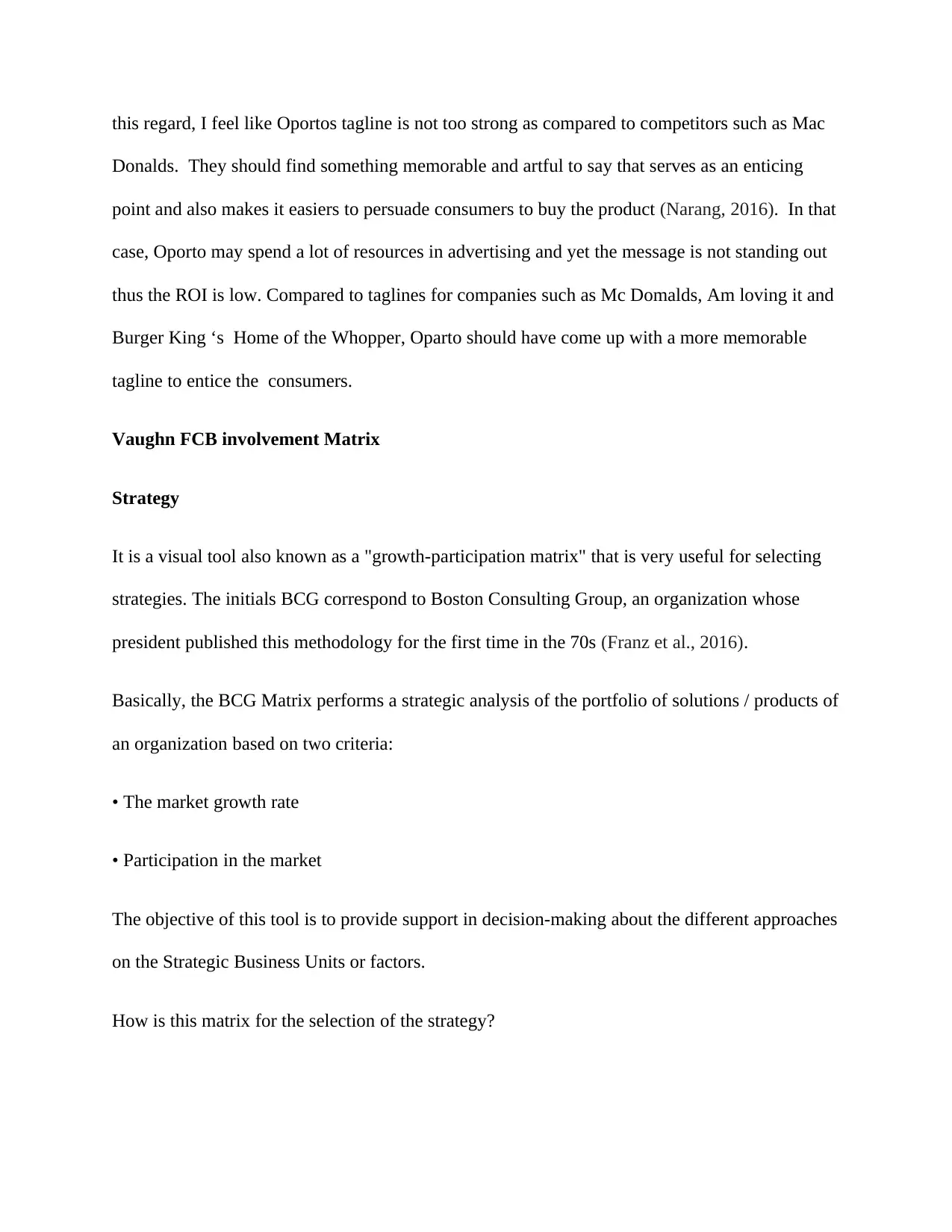
this regard, I feel like Oportos tagline is not too strong as compared to competitors such as Mac
Donalds. They should find something memorable and artful to say that serves as an enticing
point and also makes it easiers to persuade consumers to buy the product (Narang, 2016). In that
case, Oporto may spend a lot of resources in advertising and yet the message is not standing out
thus the ROI is low. Compared to taglines for companies such as Mc Domalds, Am loving it and
Burger King ‘s Home of the Whopper, Oparto should have come up with a more memorable
tagline to entice the consumers.
Vaughn FCB involvement Matrix
Strategy
It is a visual tool also known as a "growth-participation matrix" that is very useful for selecting
strategies. The initials BCG correspond to Boston Consulting Group, an organization whose
president published this methodology for the first time in the 70s (Franz et al., 2016).
Basically, the BCG Matrix performs a strategic analysis of the portfolio of solutions / products of
an organization based on two criteria:
• The market growth rate
• Participation in the market
The objective of this tool is to provide support in decision-making about the different approaches
on the Strategic Business Units or factors.
How is this matrix for the selection of the strategy?
Donalds. They should find something memorable and artful to say that serves as an enticing
point and also makes it easiers to persuade consumers to buy the product (Narang, 2016). In that
case, Oporto may spend a lot of resources in advertising and yet the message is not standing out
thus the ROI is low. Compared to taglines for companies such as Mc Domalds, Am loving it and
Burger King ‘s Home of the Whopper, Oparto should have come up with a more memorable
tagline to entice the consumers.
Vaughn FCB involvement Matrix
Strategy
It is a visual tool also known as a "growth-participation matrix" that is very useful for selecting
strategies. The initials BCG correspond to Boston Consulting Group, an organization whose
president published this methodology for the first time in the 70s (Franz et al., 2016).
Basically, the BCG Matrix performs a strategic analysis of the portfolio of solutions / products of
an organization based on two criteria:
• The market growth rate
• Participation in the market
The objective of this tool is to provide support in decision-making about the different approaches
on the Strategic Business Units or factors.
How is this matrix for the selection of the strategy?

This matrix is visually represented by four cells symbolized with different graphic concepts.
These cells are used to reflect different strategies.
The following aspects are defined in the axes of the matrix:
• Vertical: Growth in the market
• Horizontal: Market share
The factors must be placed in the quadrants according to the importance of their strategic value.
The stars are what the organization wants to invest in first. The area in which they operate is that
of high-growth areas with a high market share (Carpenter, 2015). The stars generate cash. They
are expected to go on to become cows (generators of positive cash flows), but this is not always
the case, above all, in sectors that suffer, they evolve very quickly due to technological advances.
When this happens, the star becomes a dog.
Recommendations
Whether you are preparing an ad for a one-time event, or creating a broad advertising campaign,
there are six key tips for designing highly successful print ads, which ensure that images and
texts fulfill their purpose in a few seconds, which they are fundamental to establish a solid
relationship with the consumer public.
1. Focus
The first thing That Oporto should do is make sure that they understand the message that they
want to convey. For the product that they are selling ( hamburgers). Even if the Advert is
visually appealing and the message is not clear or memorable and enticing then the whole advert
These cells are used to reflect different strategies.
The following aspects are defined in the axes of the matrix:
• Vertical: Growth in the market
• Horizontal: Market share
The factors must be placed in the quadrants according to the importance of their strategic value.
The stars are what the organization wants to invest in first. The area in which they operate is that
of high-growth areas with a high market share (Carpenter, 2015). The stars generate cash. They
are expected to go on to become cows (generators of positive cash flows), but this is not always
the case, above all, in sectors that suffer, they evolve very quickly due to technological advances.
When this happens, the star becomes a dog.
Recommendations
Whether you are preparing an ad for a one-time event, or creating a broad advertising campaign,
there are six key tips for designing highly successful print ads, which ensure that images and
texts fulfill their purpose in a few seconds, which they are fundamental to establish a solid
relationship with the consumer public.
1. Focus
The first thing That Oporto should do is make sure that they understand the message that they
want to convey. For the product that they are selling ( hamburgers). Even if the Advert is
visually appealing and the message is not clear or memorable and enticing then the whole advert
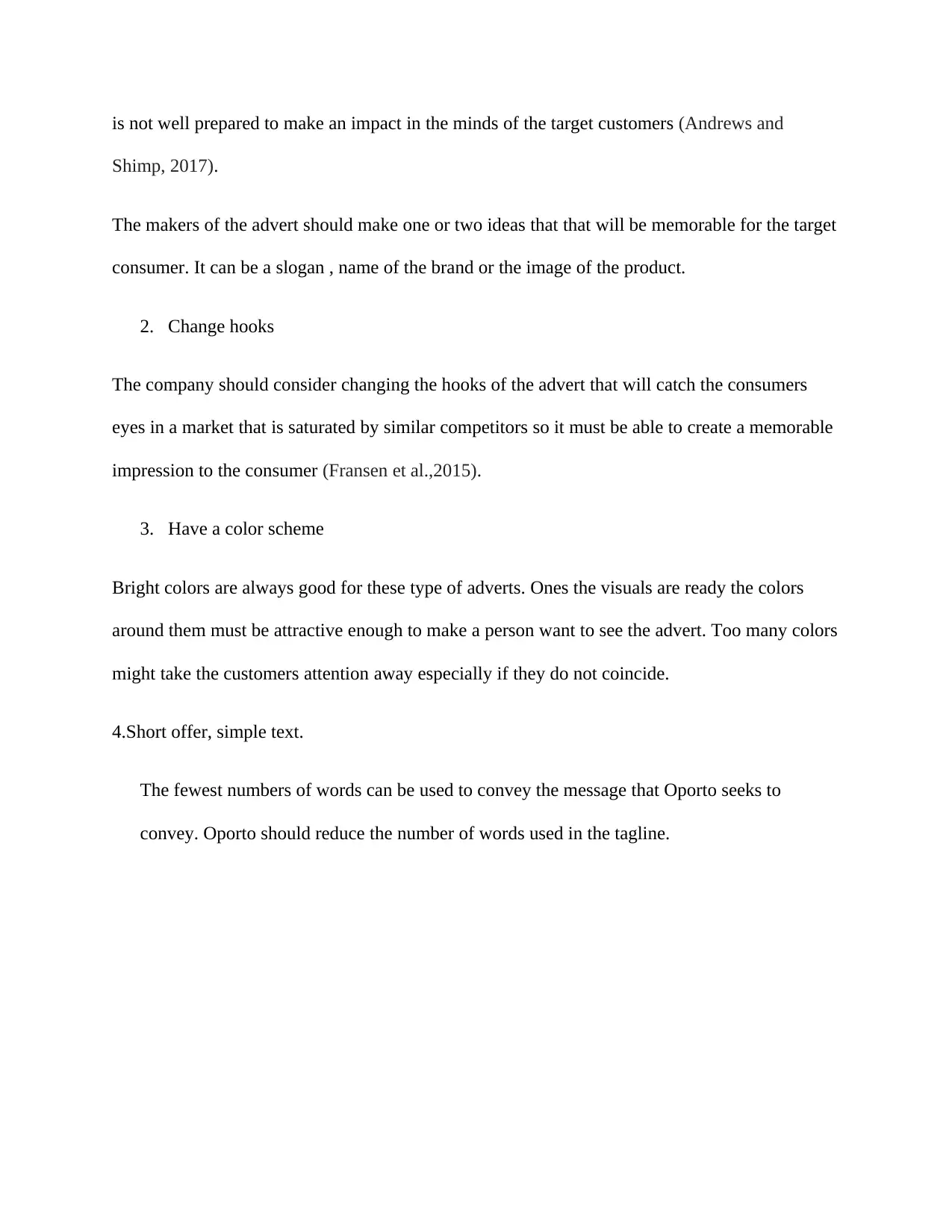
is not well prepared to make an impact in the minds of the target customers (Andrews and
Shimp, 2017).
The makers of the advert should make one or two ideas that that will be memorable for the target
consumer. It can be a slogan , name of the brand or the image of the product.
2. Change hooks
The company should consider changing the hooks of the advert that will catch the consumers
eyes in a market that is saturated by similar competitors so it must be able to create a memorable
impression to the consumer (Fransen et al.,2015).
3. Have a color scheme
Bright colors are always good for these type of adverts. Ones the visuals are ready the colors
around them must be attractive enough to make a person want to see the advert. Too many colors
might take the customers attention away especially if they do not coincide.
4.Short offer, simple text.
The fewest numbers of words can be used to convey the message that Oporto seeks to
convey. Oporto should reduce the number of words used in the tagline.
Shimp, 2017).
The makers of the advert should make one or two ideas that that will be memorable for the target
consumer. It can be a slogan , name of the brand or the image of the product.
2. Change hooks
The company should consider changing the hooks of the advert that will catch the consumers
eyes in a market that is saturated by similar competitors so it must be able to create a memorable
impression to the consumer (Fransen et al.,2015).
3. Have a color scheme
Bright colors are always good for these type of adverts. Ones the visuals are ready the colors
around them must be attractive enough to make a person want to see the advert. Too many colors
might take the customers attention away especially if they do not coincide.
4.Short offer, simple text.
The fewest numbers of words can be used to convey the message that Oporto seeks to
convey. Oporto should reduce the number of words used in the tagline.
Paraphrase This Document
Need a fresh take? Get an instant paraphrase of this document with our AI Paraphraser
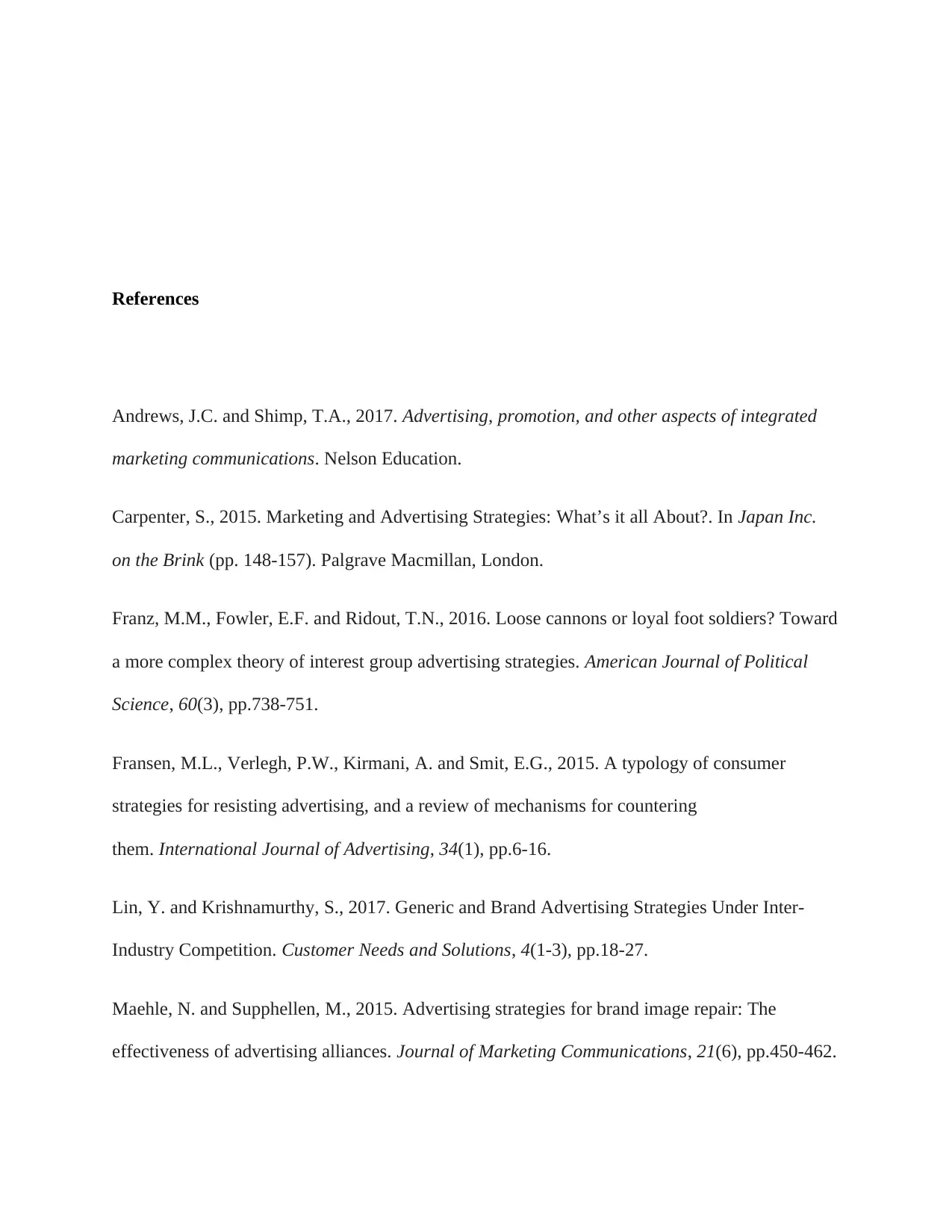
References
Andrews, J.C. and Shimp, T.A., 2017. Advertising, promotion, and other aspects of integrated
marketing communications. Nelson Education.
Carpenter, S., 2015. Marketing and Advertising Strategies: What’s it all About?. In Japan Inc.
on the Brink (pp. 148-157). Palgrave Macmillan, London.
Franz, M.M., Fowler, E.F. and Ridout, T.N., 2016. Loose cannons or loyal foot soldiers? Toward
a more complex theory of interest group advertising strategies. American Journal of Political
Science, 60(3), pp.738-751.
Fransen, M.L., Verlegh, P.W., Kirmani, A. and Smit, E.G., 2015. A typology of consumer
strategies for resisting advertising, and a review of mechanisms for countering
them. International Journal of Advertising, 34(1), pp.6-16.
Lin, Y. and Krishnamurthy, S., 2017. Generic and Brand Advertising Strategies Under Inter-
Industry Competition. Customer Needs and Solutions, 4(1-3), pp.18-27.
Maehle, N. and Supphellen, M., 2015. Advertising strategies for brand image repair: The
effectiveness of advertising alliances. Journal of Marketing Communications, 21(6), pp.450-462.
Andrews, J.C. and Shimp, T.A., 2017. Advertising, promotion, and other aspects of integrated
marketing communications. Nelson Education.
Carpenter, S., 2015. Marketing and Advertising Strategies: What’s it all About?. In Japan Inc.
on the Brink (pp. 148-157). Palgrave Macmillan, London.
Franz, M.M., Fowler, E.F. and Ridout, T.N., 2016. Loose cannons or loyal foot soldiers? Toward
a more complex theory of interest group advertising strategies. American Journal of Political
Science, 60(3), pp.738-751.
Fransen, M.L., Verlegh, P.W., Kirmani, A. and Smit, E.G., 2015. A typology of consumer
strategies for resisting advertising, and a review of mechanisms for countering
them. International Journal of Advertising, 34(1), pp.6-16.
Lin, Y. and Krishnamurthy, S., 2017. Generic and Brand Advertising Strategies Under Inter-
Industry Competition. Customer Needs and Solutions, 4(1-3), pp.18-27.
Maehle, N. and Supphellen, M., 2015. Advertising strategies for brand image repair: The
effectiveness of advertising alliances. Journal of Marketing Communications, 21(6), pp.450-462.
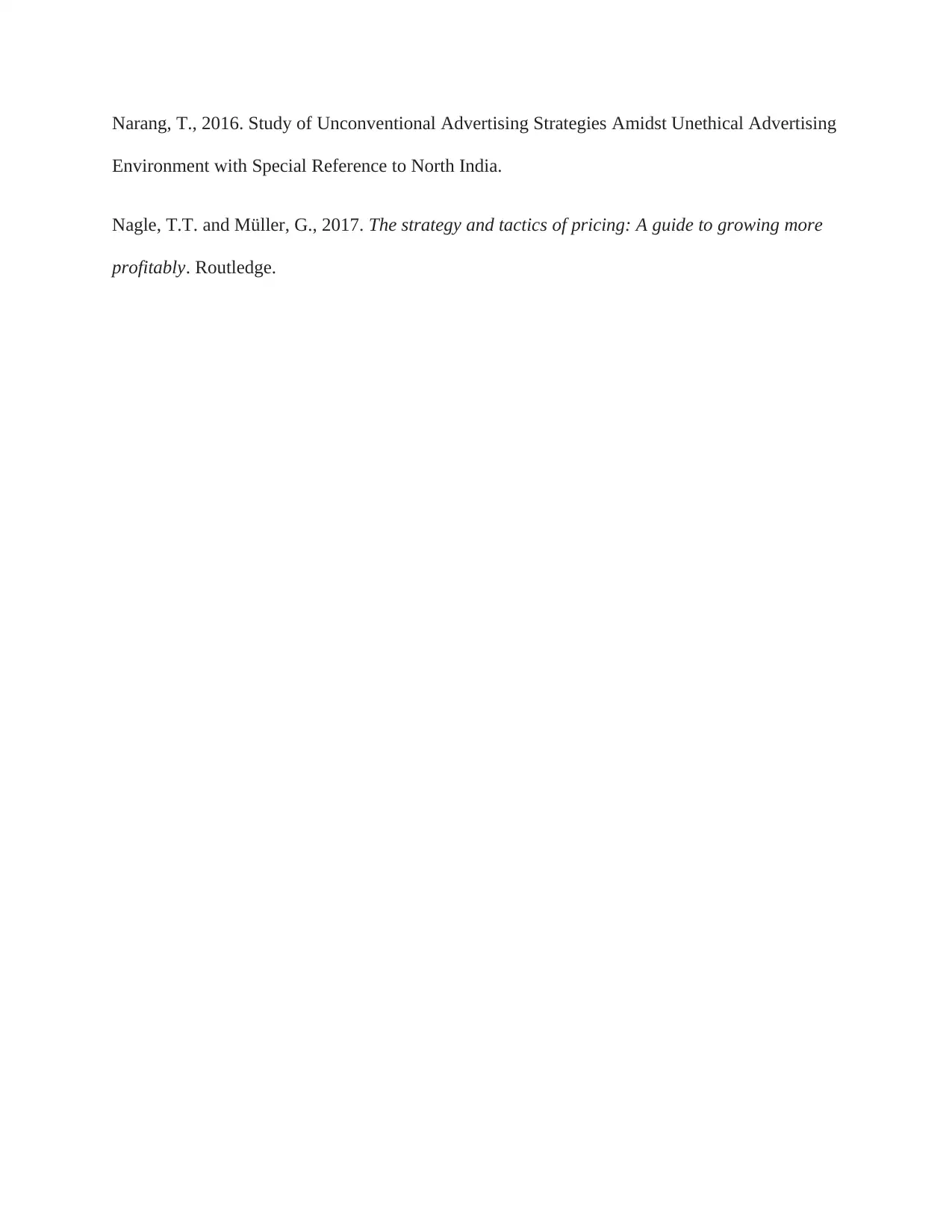
Narang, T., 2016. Study of Unconventional Advertising Strategies Amidst Unethical Advertising
Environment with Special Reference to North India.
Nagle, T.T. and Müller, G., 2017. The strategy and tactics of pricing: A guide to growing more
profitably. Routledge.
Environment with Special Reference to North India.
Nagle, T.T. and Müller, G., 2017. The strategy and tactics of pricing: A guide to growing more
profitably. Routledge.
1 out of 9
Your All-in-One AI-Powered Toolkit for Academic Success.
+13062052269
info@desklib.com
Available 24*7 on WhatsApp / Email
![[object Object]](/_next/static/media/star-bottom.7253800d.svg)
Unlock your academic potential
© 2024 | Zucol Services PVT LTD | All rights reserved.